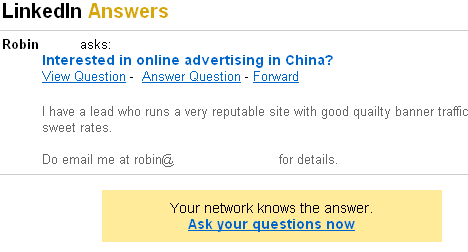Spammed through LinkedIn? Time to nuke a connection. Here's how.

I have this love-hate relationship with LinkedIn. The folks at LinkedIn may disagree, but for those of you not familiar with the service, LinkedIn is a Web-based version of your Outlook address book. Throw in some steroids. Not only can you you use it to use the Web for personal contact tracking, it's also a business tool for crawling the tentacles of your contact network to get introduced to people you might otherwise have difficulty getting introduced you. You know Dick. Dick knows Jane. But you don't know Jane. LinkedIn can automatically find the shortest distance (Dick) between you and Jane, and pull Dick into the process of making the introduction Jane.
I've written about these guys before (see LinkedIn vs. Plaxo: Is LinkedIn winning?, Will social databases give way to social protocols, and my interview with LinkedIn co-founder Konstantin Guericke. Also, see why Larry thinks Yahoo should acquire LinkedIn).
Depending on how you set your profile, new members of the LinkedIn community can search the community for existing members that they already know and, using an "Invitation to Connect," ask for permission to programmatically connect the their profile to yours. On average, I think I receive about three of these invitations a week, the most recent of which came today (see below) from my friend Barbara who is off in some exotic land while she figures out her next move in the business world (last name rubbed out):

I accepted, a process that could be much more frictionless if all I had to do was click the "Accept Invitation" button. But you have to accept again once clicking the above button takes you to the LinkedIn Web site.
Once, I used LinkedIn to see if someone else knew a person I was trying to get a hold of and when I realized there was just one degree of separation, I picked up the phone and called the middleman instead of using LinkedIn to make it happen. Once (I think), someone used me to make an introduction. It was of a highly confidential natures -- one vendor reaching out to another -- and they forgot I was with the press. Fortunately, for them, I never wrote about it.
For the most part, I like LinkedIn. Almost all of my "connections" are with people I know personally and, on occasion, I've used it to make contact with them because the most recent information I have for them in my Rolodex (a term I use loosely to describe all my "local" repositories -- Outlook, business cards, etc. -- where keep contact information) is out of date.
Theoretically, the way LinkedIn works, you shouldn't get pestered too much, especially by people you don't know. If you do get pestered (perhaps for an introduction), then it's usually by someone you know and if you know them well enough, you should be happy to handle their request. But I, like others, have made the mistake of accepting invitations like the one above from people I don't know. I get so few of them and sometimes, it appears as though the person knows me, that I feel as though there's no harm in letting them link to me. However, today, I was reminded of how accepting invitations from people you don't know can put you in harm's way.
In both my e-mail inbox (LinkedIn is programmed to forward personal "events" to my inbox) and my LinkedIn inbox, I received the following proposal from "Robin" (a person that I don't think I know, but that I allowed into my "personal network"). Again, the last name is rubbed out.

This pitch reads like a lot of e-mail I'd rather not get. In my mind (beauty is in the eyes of the beholder), it's unsolicited commercial e-mail (UCE), otherwise known as spam and the penalty I'd like Robin to pay for invading my inbox is for him to be removed from my contact network so he can't do this again. If only it were so simple with the rest of my e-mail. Actually, if only only it were so simple with LinkedIn too. Personally, what I'd like to see is a big red "Nuke Contact" button right on the e-mail that eviscerates any trace of the fact that Robin was once a contact I let into my network. There isn't. At the bottom of the e-mail is a sentence with a link that says:
If you are not interested in being notified about questions from your connections your may change your LinkedIn Answers notifications settings.
For some strange reason (coincidence?), whereas the path to removing connections is a bit obscure, the ability to accept an invitation (or make connections) look like a giant billboards on Rt. 66. I understand why. LinkedIn's value proposition (particularly if Larry is right about it potentially get acquired) is grounded in the longevity of these connections. Not the ease in breaking them. I called the press office at LinkedIn. I left a message after being told it could take a couple of days for someone to get back to me (not fast enough in blogosphere time). I called technical support when, at first, I couldn't find what I was looking for. I was told to leave a message there too (but, unlike with the press line, there was no indication when I'd get a call back). At least LinkedIn has a telephone number (which is more than I can say for a lot of Web outfits).
Bottom line? Robin has been nuked. I wish it was easier to do. And, if you're reading this Robin, don't take it personally. What you have to offer is apparently of value to others. Just not me.